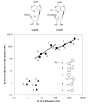Semi-rational design of (north)-methanocarba nucleosides as dual acting A(1) and A(3) adenosine receptor agonists: novel prototypes for cardioprotection
- PMID: 16366590
- PMCID: PMC2597460
- DOI: 10.1021/jm050726b
Semi-rational design of (north)-methanocarba nucleosides as dual acting A(1) and A(3) adenosine receptor agonists: novel prototypes for cardioprotection
Abstract
Ring-constrained adenosine analogues have been designed to act as dual agonists at tissue-protective A(1) and A(3) adenosine receptors (ARs). 9-Ribosides transformed into the ring-constrained (N)-methanocarba-2-chloro-5'-uronamides consistently lost affinity at A(1)/A(2A)ARs and gained at A(3)AR. Among 9-riboside derivatives, only N(6)-cyclopentyl and 7-norbornyl moieties were extrapolated for mixed A(1)/A(3) selectivity and rat/human A(3)AR equipotency. Consequently, 2 was balanced in affinity and potency at A(1)/A(3)ARs as envisioned and dramatically protected in an intact heart model of global ischemia and reperfusion.
Figures



Similar articles
-
Activation of A1, A2A, or A3 adenosine receptors attenuates lung ischemia-reperfusion injury.J Thorac Cardiovasc Surg. 2010 Aug;140(2):440-6. doi: 10.1016/j.jtcvs.2010.03.002. Epub 2010 Apr 15. J Thorac Cardiovasc Surg. 2010. PMID: 20398911 Free PMC article.
-
Adenosine A₂A and A₂B receptors are both required for adenosine A₁ receptor-mediated cardioprotection.Am J Physiol Heart Circ Physiol. 2011 Sep;301(3):H1183-9. doi: 10.1152/ajpheart.00264.2011. Epub 2011 Jul 8. Am J Physiol Heart Circ Physiol. 2011. PMID: 21743001 Free PMC article.
-
(N)-methanocarba 2,N6-disubstituted adenine nucleosides as highly potent and selective A3 adenosine receptor agonists.J Med Chem. 2005 Mar 24;48(6):1745-58. doi: 10.1021/jm049580r. J Med Chem. 2005. PMID: 15771421 Free PMC article.
-
Adenosine receptor-mediated cardioprotection: are all 4 subtypes required or redundant?J Cardiovasc Pharmacol Ther. 2012 Mar;17(1):21-33. doi: 10.1177/1074248410396877. Epub 2011 Feb 18. J Cardiovasc Pharmacol Ther. 2012. PMID: 21335481 Review.
-
Adenosine and adenosine receptors in the immunopathogenesis and treatment of cancer.J Cell Physiol. 2018 Mar;233(3):2032-2057. doi: 10.1002/jcp.25873. Epub 2017 May 3. J Cell Physiol. 2018. PMID: 28233320 Review.
Cited by
-
Potent and Selective Human 5-HT2B Serotonin Receptor Antagonists: 4'-Cyano-(N)-methanocarba-adenosines by Synthetic Serendipity.J Med Chem. 2024 Dec 12;67(23):21264-21291. doi: 10.1021/acs.jmedchem.4c02174. Epub 2024 Nov 26. J Med Chem. 2024. PMID: 39589936
-
Role of Adenosine and Purinergic Receptors in Myocardial Infarction: Focus on Different Signal Transduction Pathways.Biomedicines. 2021 Feb 18;9(2):204. doi: 10.3390/biomedicines9020204. Biomedicines. 2021. PMID: 33670488 Free PMC article. Review.
-
A3 Adenosine Receptors as Modulators of Inflammation: From Medicinal Chemistry to Therapy.Med Res Rev. 2018 Jul;38(4):1031-1072. doi: 10.1002/med.21456. Epub 2017 Jul 6. Med Res Rev. 2018. PMID: 28682469 Free PMC article. Review.
-
Machine Learning for Discovery of New ADORA Modulators.Front Pharmacol. 2022 Jun 22;13:920643. doi: 10.3389/fphar.2022.920643. eCollection 2022. Front Pharmacol. 2022. PMID: 35814244 Free PMC article.
-
Stimulation of the P2X7 receptor kills rat retinal ganglion cells in vivo.Exp Eye Res. 2010 Sep;91(3):425-32. doi: 10.1016/j.exer.2010.06.017. Epub 2010 Jul 1. Exp Eye Res. 2010. PMID: 20599962 Free PMC article.
References
-
- Yao L, Burbiel JC, Maass A, Müller CE. Adenosine receptor agonists: from basic medicinal chemistry to clinical development. Expert Opin Emerging Drugs. 2003;8:537–576. - PubMed
-
- Liu GS, Richards SC, Olsson RA, Mullane K, Walsh RS, Downey JM. Evidence that the adenosine A3 receptor may mediate the protection afforded by preconditioning in the isolated rabbit heart. Cardiovasc Res. 1994;28:1057–1061. - PubMed
-
- Tracey WR, Magee WP, Oleynek JJ, Hill RJ, Smith AH, Flynn DM, Knight DR. Novel N6-substituted adenosine 5′-N-methyluronamides with high selectivity for human adenosine A3 receptors reduce ischemic myocardial injury. AmJ Physiol Heart Circ Physiol. 2003;285:H2780. - PubMed
Publication types
MeSH terms
Substances
Grants and funding
LinkOut - more resources
Full Text Sources
Other Literature Sources
Chemical Information
Research Materials

